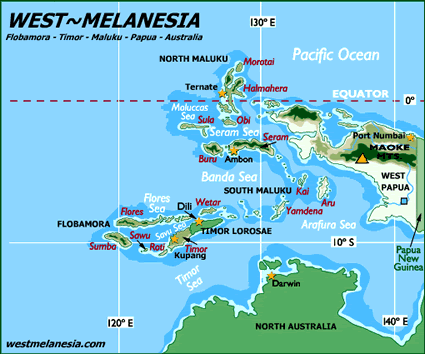The Galela live in northeast Halmahera and on Morotai, Bacan, and Obi Islands. In 11 villages around Lake Galela, several thousand Galela speak the Kadina target dialect. Historically the Galela were sea-faring pirates who engaged in slave trade and manned war canoes for the Sultan of Ternate.
In the year 2000, most became displaced refugees due to civil war. Over 5,000 people are said to have died in North Maluku. Many of the Galela have begun to cautiously return to their lands near the end of 2002.
In Duma village, children learn North Moluccan Malay first and eventually begin to learn Galela around age 8 or 9, since it is needed for social and ethnic identity. In other villages, Galela is learned first.
In modern times they are subsistence farmers and fishermen. The main cash crop is copra. Some people specialize in carpentry, masonry, and other part-time industries or work in government offices.
The Galela people are loosely organized socially but have a fierce ethnic pride. The language of the home is Galela, at least for adults.
A little over half are Muslim, but most of the others are Christians. There are underlying strata of syncretized animism in the practice of both religions.
Most church services had been conducted in some level of Indonesian, but mid-week home services were often conducted in the vernacular. A volume containing Genesis and the New Testament in the Galela language was dedicated September 26, 2002, and a national team is now distributing the 6,000 copies and training church leadership to use it in their ministry and church services. The desire is to hold the entire worship service in the vernacular. Funding is still needed for the team to hold both a workshop for a group training of these church leaders and a seminar to train them in one-on-one evangelism.
They need more hospitals for medical emergencies.
Pray for a multiplying movement of disciples who will bring healing, unity, and lasting hope, transforming entire villages through the power of Christ.
Pray that soon they will become Christ's ambassadors to disciple less-reached nations.
Pray for the Lord to bless Kamoro Christian believers with an abundance of God's love, joy, and kindness, drawing others to the King of kings.
Pray for them to be grateful for God's spiritual and physical provisions.
Pray that the Holy Spirit will move powerfully, so that they may become a light to those who still lack a relationship with Jesus Christ.
Scripture Prayers for the Galela in Indonesia.
Anonymous
| Profile Source: Joshua Project |











